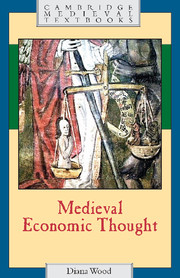Book contents
- Frontmatter
- Contents
- Preface
- List of abbreviations
- Introduction: problems, evidence, and background
- 1 Private property versus communal rights: the conflict of two laws
- 2 Wealth, beggary, and sufficiency
- 3 What is money?
- 4 Sovereign concerns: weights, measures, and coinage
- 5 The mercantile system
- 6 The just price and the just wage
- 7 The nature of usury: the usurer as winner
- 8 The theory of interest: the usurer as loser
- Conclusion
- Appendix: Notes on the main writers and anonymous works mentioned in the text
- Glossary of terms
- Select bibliography
- Index
- Cambridge Medieval Textbooks
7 - The nature of usury: the usurer as winner
Published online by Cambridge University Press: 05 June 2012
- Frontmatter
- Contents
- Preface
- List of abbreviations
- Introduction: problems, evidence, and background
- 1 Private property versus communal rights: the conflict of two laws
- 2 Wealth, beggary, and sufficiency
- 3 What is money?
- 4 Sovereign concerns: weights, measures, and coinage
- 5 The mercantile system
- 6 The just price and the just wage
- 7 The nature of usury: the usurer as winner
- 8 The theory of interest: the usurer as loser
- Conclusion
- Appendix: Notes on the main writers and anonymous works mentioned in the text
- Glossary of terms
- Select bibliography
- Index
- Cambridge Medieval Textbooks
Summary
INTRODUCTION: DEFINITIONS AND FOUNDATIONS
The just price and usury were once inseparably linked by historians – indeed, for some people the two still constitute the sum total of medieval economic thought. In fact, they are completely different. The just price was accepted by the scholastics as grounded on justice and equality, either arithmetical or proportional, while usury – that is, making a charge for lending money – was grounded on injustice and inequality.
How was usury defined? Usury was concerned with lending, especially the lending of money, although it could be applied to anything that could be counted, weighed, or measured. The definitions were based ultimately on biblical texts, both Old Testament ones along the lines of ‘Take thou no usury …’ (Leviticus 25.36), and the New Testament Sermon on the Mount of Luke 6.35, ‘Lend, hoping for nothing again.’ Two definitions feature in Gratian's Decretum, both of them citing patristic texts. They emphasize two different aspects of the question. The first is ‘expecting to receive back more than you have given’ in a loan, whether of money or anything else, and it underlines the sinful intention of the usurer. It echoed the Luke text, and formed the basis for the all-important idea that the sinful hope was what defined usury. Urban III (1185–87) issued a decretal called Consuluit, where he quoted the Luke text, and made the point that usury was a sin of intention. This became the acid test.
- Type
- Chapter
- Information
- Medieval Economic Thought , pp. 159 - 180Publisher: Cambridge University PressPrint publication year: 2002
- 1
- Cited by



